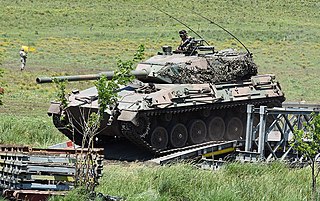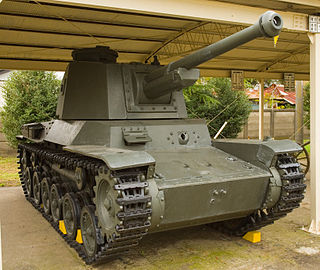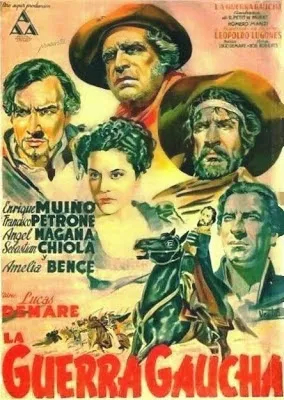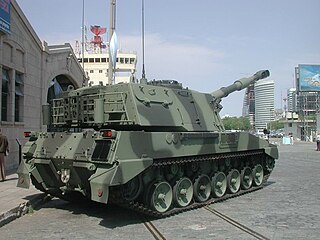
The M4 Sherman, officially medium tank, M4, was the medium tank most widely used by the United States and Western Allies in World War II. The M4 Sherman proved to be reliable, relatively cheap to produce, and available in great numbers. It was also the basis of several other armored fighting vehicles including self-propelled artillery, tank destroyers, and armored recovery vehicles. Tens of thousands were distributed through the Lend-Lease program to the British Commonwealth, Soviet Union, and other Allied Nations. The tank was named by the British after the American Civil War General William Tecumseh Sherman.

The Panzerkampfwagen 38(t), originally known as the ČKD LT vz. 38, was a tank designed during the 1930s, which saw extensive service during World War II. Developed in Czechoslovakia by Českomoravská Kolben-Daněk (ČKD), the type was adopted by Nazi Germany following the annexation of Czechoslovakia. With the German Army and other Axis forces, the type saw service in the invasions of Poland, France and the USSR. Production ended in 1942, when its main armament was deemed inadequate. In all, over 1,400 Pz. 38(t)s were manufactured. The chassis of the Pz. 38(t) continued to be produced for the Marder III (1942–1944) with some of its components used in the later Jagdpanzer 38 (1944–1945) tank destroyer and its derivative vehicles.

The M3 Lee, officially Medium Tank, M3, was an American medium tank used during World War II. The turret was produced in two different forms, one for US needs and one modified to British requirements to place the radio next to the commander. In British Commonwealth service, the tank was called by two names: tanks employing US-pattern turrets were called "Lee", named after Confederate general Robert E. Lee, while those with British-pattern turrets were known as "Grant", named after Union general Ulysses S. Grant.

Crusader, in full "Tank, Cruiser Mk VI, Crusader", also known by its General Staff number A.15, was one of the primary British cruiser tanks during the early part of the Second World War. Over 5,000 tanks were manufactured and they made important contributions to the British victories during the North African campaign. The Crusader only saw active service in Africa but the chassis of the tank was modified to create anti-aircraft, fire support, observation, communication, bulldozer and recovery vehicle variants.

The Sherman Firefly was a medium tank used by the United Kingdom and some armoured formations of other Allies in the Second World War. It was based on the US M4 Sherman but was fitted with the more powerful British 76.2 mm (3.00 in) calibre 17-pounder anti-tank gun as its main weapon. Conceived as a stopgap until future British tank designs came into service, the Sherman Firefly became the most common vehicle mounting the 17-pounder in the war.

The Tanque Argentino Mediano is a medium tank in service with the Argentine Army. Lacking the experience and resources to design a tank, the Argentine Ministry of Defense contracted German company Thyssen-Henschel. The vehicle was developed by a German and Argentine team of engineers, and was based on the German Marder infantry fighting vehicle chassis.

A flame tank is a type of tank equipped with a flamethrower, most commonly used to supplement combined arms attacks against fortifications, confined spaces, or other obstacles. The type only reached significant use in the Second World War, during which the United States, Nazi Germany, Soviet Union, Italy, Japan, and the United Kingdom all produced flamethrower-equipped tanks.

Type 3 medium tank Chi-Nu was a medium tank of the Imperial Japanese Army in World War II. Like the Type 1 Chi-He, this tank was an improved version of the Type 97 Chi-Ha. It incorporated a Type 3 75 mm tank gun, one of the largest Japanese tank guns during the war.

This article deals with Sherman tanks extensive use around the world after World War II and catalogues foreign post–World War II use and conversions of Sherman tanks and variants based on the Sherman chassis.

The Gaucho War is a 1942 Argentine historical drama and epic film directed by Lucas Demare and starring Enrique Muiño, Francisco Petrone, Ángel Magaña, and Amelia Bence. The film's script, written by Homero Manzi and Ulyses Petit de Murat, is based on the novel by Leopoldo Lugones published in 1905. The film premiered in Buenos Aires on November 20, 1942 and is considered by critics of Argentine cinema to be one of the most successful films in history. It won three Silver Condor awards, including Best Film, Best Director, and Best Adapted Screenplay, given by the Argentine Film Critics Association at the 1943 Argentine Film Critics Association Awards for the best films and performances of the previous year.

Stridsvagn m/42 was a Swedish medium tank in service in the World War II period. Known by its manufacturer AB Landsverk as Lago II-III-IV, it fielded a 75 mm L/31 gun, the first of its size in a Swedish tank. It entered service with the Swedish Army in April 1943. Modern in design and mobile, a total of 282 were produced.
The Chaco War (1932–35), between Bolivia and Paraguay, was the first South American conflict in which tanks were employed. They originated exclusively from Bolivia, but Paraguay operated tanks captured from Bolivia during the war.

The VCA-155 is a self-propelled 155 mm gun/howitzer, manufactured by TAMSE which entered service in the late 1990s.

The Second Battle of Nanawa was fought from the 4 to 9 July 1933, between the Bolivian and Paraguayan armies during the Chaco War. It was one of the bloodiest battles fought in South America in the 20th century, coming to be labeled as the "South American Verdun" by comparison with the Battle of Verdun of World War I.

The "Patagón" tank is a light tank developed in Argentina during the early 2000s, that was expected to enter service with the Argentine Army. It is based on a SK-105 Kürassier chassis with a refurbished AMX-13 turret. The project was cancelled in late 2008 after five tanks were converted.

Fabricaciones Militares Sociedad del Estado, is a state-owned Argentine arms manufacturer based in Buenos Aires. The company was a government agency under the name Dirección General de Fabricaciones Militares.
ARA Ingeniero Julio Krause (B-13) was an oil tanker ship in service with the Argentine Navy from 1993 to 2015, and with YPF from to 1981 to 1993. She was the first ship in the Argentine Navy to bear the name of Argentine engineer Julio Krause, who discovered oil in Comodoro Rivadavia in 1907.
The 601 Signals Grouping is the only signal grouping unit of the Argentine Army (EA) that specialized in electronic warfare, military communications, and signals intelligence (SIGINT). It is headquartered at the City Bell Army Garrison, Buenos Aires Province.

The Vehículo Anfibio de Exploración was an armored personnel carrier project developed by Argentina in the 1970s.

The Vehículo Anfibio Pesado de Exploración was a wheeled amphibious reconnaissance vehicle project developed by Argentina in the 1970s. Commissioned by the Argentine Army, two prototypes were developed by the French companies Renault and Panhard. On top of reconnaissance, the vehicle was also designed for direct infantry support and anti-tank warfare.

















